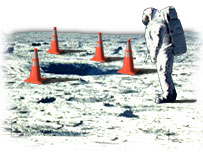The US plans to return to the moon and establish the first base there, which will serve as a transition point on the way to a manned journey to Mars. The question arises as to how the work and living on the moon will affect the mental state of the astronauts

The US plans to return to the moon and establish the first base there, which will serve as a transition point on the way to a manned journey to Mars. The question arises as to how the work and living on the moon will affect the mental state of the astronauts.
Neil Armstrong's words from the moon to an audience of one billion people on July 21, 1969: "The place has a desolate beauty of its own. There is a lot of similarity to the High Desert in the USA.”
The big difference lies in the fact that the High Desert is just a drive away from the California prairies, while a visit to the moon is three days of jolting through space at 11 miles per second.
NASA will probably have no problem finding volunteers to man the long-term base on the moon, the establishment of which was announced by US President George Bush. What exactly are they getting themselves into?
A dozen astronauts walked on the moon between 1969-1972. This experience changed their lives, sometimes dramatically. Buzz Aldrin struggled with alcoholism, while Edgar Mitchell of Apollo 14 became a paranormal investigator. Following Apollo 15, the late James Irwin became a devout Catholic and headed to Mount Ararat in search of Noah's Ark.
Getting to the moon is not as difficult as a six-month journey to Mars, but still makes high demands on machines and people. The lack of political enthusiasm was the main reason for stopping the landings on the moon after December 1972. The flight planners also understood that any further flight was a risk - it is better to end on a high note than to continue to tempt fate.
When traveling to the moon, the astronauts leave the protection of the Earth's magnetic field. Astronauts aboard the International Space Station remain in orbit low enough not to lose this protection, but moving away from Earth exposes astronauts to cosmic radiation and the occasional solar flare. The Apollo astronauts experienced a large number of colored flashes. These flashes have been called "ghosts", and they are caused by charged particles that meet the optic nerves.
Astronauts on the moon are just as vulnerable. During each Apollo mission, a network of observatories scanned the Sun for signs of unusual activity, but if a solar flare appeared after launch, the astronauts had no protection.
During August 1972 a particularly strong solar flare erupted. If an astronaut had been exposed to it, he would have died within a few hours. Any lunar base, therefore, would have to include a radiation protection shelter below the surface.
Do not think that building the shelter will be an easy task. It is difficult to dig in the compacted lunar soil more than 15 cm. Also, once the moon dust is dispersed, it gets everywhere.
"One of the most limiting facts in lunar exploration is the dust and its tendency to stick to any material," recalled Eugene Kernan after Apollo 17. "Simple things such as the various latches on the rover began not only to function poorly but really not to function at all."
Space Suits Wear Out Quickly: Kernan's teammate Harrison Schmidt scratched his sun visor until it was unusable while trying to dust it off. He was also found to be allergic to moon dust.
All the evidence suggests that prolonged stay in six times less gravity is actually healthier than the zero gravity that astronauts on the space station endure. The zero gravity environment leads to bone depletion and muscle atrophy.
The lunar environment is demanding in other respects. The rocky surface of the moon brings with it nerve-racking landings, and spacecraft orbiting the moon are pulled out of orbit by the effect of "mescones" - denser regions of the moon's crust.
One proposal, which aims to facilitate the operations of the spacecraft, is the foundation of a network of lunar GPS satellites, which will enable efficient automation of navigation and landings.
Such a network will turn out to be useful, since astronauts will be able to explore areas very different from the equatorial regions, which were studied in the previous times, including areas permanently shadowed by craters at the poles. This is of course provided that activity in such extreme cold is feasible.
If these areas cannot be reached due to the cold, robots will enter the picture. A roadmap, prepared by the International Space Research Group, proposed a "robotic village" of advanced rovers that would wait for the astronauts to land.
The feeling of loneliness, which the long stay on a base on the moon will evoke, will be a psychological obstacle, but in general the mission can be compared to service on a base in Antarctica or a nuclear submarine. The significant difference is that every time you look up you will see the house and remember how far it is.
"I raised my thumb and closed one eye. My thumb hid the Earth," Armstrong reported after landing. "I didn't feel like a giant, I felt very tiny."
Among the advantages of establishing a base on the moon it can be said that its establishment will be cheaper than maintaining the International Space Station. Anything in Earth orbit needs expensive rockets to get it there, but the Moon already has a supply of raw materials.
Researchers at the Houston Johnston Space Center turned simulated lunar material into concrete and glass. There is also no need to worry about running out of air: lunar dust consists of 40% oxygen.
Most of all, if we ever become adept at living on the moon, we can live on other planetary bodies throughout the solar system, from Mercury to Pluto.
